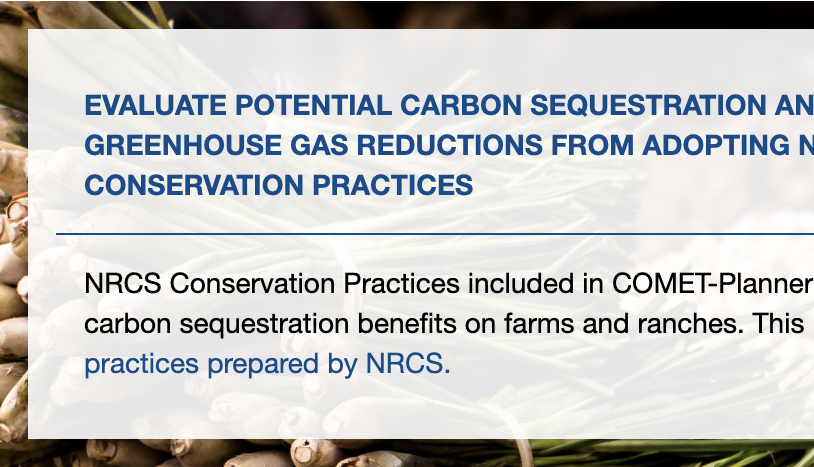Frequently asked questions
Carbon sequestration refers to a natural or artificial process by which carbon dioxide is removed from the atmosphere and held or stored in solid or liquid form. In our environment carbon sequestration is the natural process by which atmospheric carbon dioxide is taken up by trees, grasses, lichens and other plants through photosynthesis and stored as carbon in the bodies of plants (trunks, branches, leaves, roots) and in soils.
Humans and our agricultural systems can either make or break the carbon cycle. Whether cows are bad for the climate (as net sources of greenhouse gas emissions) or good (contributing to cycles that sequester more carbon than they produce) depends on how and what we feed them, take care of them and how we manage their waste. Grazed grassland systems coevolved with ungulates (grazing animals such as cows, buffalo and elk), and these systems thrive under good grazing management. Grazing grasslands keeps them healthy and is an important part of the whole ecosystem. However, overgrazing and cutting down forests for grazing are both poor environmental practices and damage the land.
Carbon farming is a process designed to maximize agriculture’s potential for moving excess GHG’s from the atmosphere and storing them into the soil and vegetation, building fertility, productivity and resilience. It focuses on carbon as a key agricultural element and involves implementing common practices known to enhance the transfer and storage of atmospheric carbon dioxide (CO2) as soil and biomass carbon. This is done through common practices that support plant photosynthesis, increase soil organic matter and reduce erosion. Because water retention and nutrient availability increase with more carbon is in the soil, carbon farming helps ranchers and farmers increase production, enhance resilience to drought and reduce input costs over time.
Carbon Farm Plans are guidance documents for landowners and agencies outlining a suite of conservation practices that address on-farm resource concerns and GHG reductions. Plans are designed to help land managers meet their natural resource management goals while supporting productive lands, thriving streams and on-farm wildlife habitat.
A Carbon Farm Plan can be created and completed collaboratively by agricultural producer with the assistance of local land managers such as the NRCS, Resource Conservation Districts, Land Trusts and/or qualified land managers/consultant.
Based on the principles and structure of NRCS Conservation Planning, Carbon Farm Plans focus on identifying those agricultural conservation practices that will enhance soil organic matter and water-holding capacity and reduce greenhouse gas emissions on-site. Carbon sequestration estimates are calculated using the USDA NRCS COMET Tools, COMET-Planner (for basic carbon sequestration) and COMET-Farm (for more N-depth whole farm analysis).
For more, see: NRCS Guidance on Carbon Farm Planning
Be Proactive! If you are an agricultural producer, there are a few options, two common ones are: (1) You may decide to implement the plan on your own. (2) You may use a carbon farm plan to apply for funding opportunities offered through your local RCD, USDA NRCS office or land trust. In Marin County, agricultural producers who have carbon farm plans are often ranked higher for funding programs. You will need to meet with RCD and NRCS staff to determine which practices are prioritized for funding for any given year and funding source. For example, compost application may be a high priority for the RCD whereas riparian restoration may be a high priority for USDA NRCS. Producers are encouraged to apply to both agencies to maximize funding opportunities.
California Financial Resources
California Healthy Soils Initiative offers a partial incentive for compost purchased from state-certified facilities on an annual grant basis, and for other carbon farming practices.
NRCS Environmental Quality Incentives Program (EQIP) funds to help cover amendments for farm nutrient management, as well as a full suite of carbon farming practices. Compost application on rangelands is in the process of becoming an approved practice, but it is not yet available for EQUIP funds.
The Marin RCD staff was part of the Marin Carbon Project from the beginning. Staff followed and participated in UC Berkeley’s research trial work on compost application, attended training seminars at Colorado State University and worked directly with willing demonstration farms in creation of the first carbon farm plans. If you are an RCD or land manager interested in carbon farm training workshops, please email Pelayo Alvarez at palvarez@carboncycle.org.
Soil organic matter (SOM) is the organic component of soil consisting of tissues of plants, animals or microorganisms that are currently or were once living which are in a phase of decomposition. SOM enhances the three properties of soil: chemical, physical, and biological characteristics by contributing to soil productivity, increases nutrient exchange, improving water infiltration, improving water holding capacity, reducing compaction, and enhancing biological activities in the soil. Approximately 50% of SOM is carbon (C). Through practices like excessive tilling and leaving the ground bare, SOM is lost to the atmosphere as CO2. By using practices that build and protect SOM, it’s possible to heal degraded land and build healthy soil.
To learn more, see: NRCS Soil Quality Kit
A healthy soil is full of life, high in organic matter, full of nutrients, and has good structure. It serves as the base for an abundant ecosystem. It’s easy to see the difference between light-colored, dry, crumbly or dusty dirt and rich, dark, moist, healthy soil. Healthy soil helps protect crops from extreme weather because soil it has higher organic matter: it absorbs and holds more water keeping plants healthy for longer and regulating temperature (staying cooler in summer and warmer in winter).
There are many benefits for water such as: increasing infiltration rates (reducing runoff, erosion and flooding) increasing water holding capacity (keeping soils wetter for longer and therefore reducing the need to irrigate), better ground water recharge and enhanced water filtration. In our natural systems, you can think of water following carbon. In the soil, when you increase carbon you enhance the soil’s ability to capture and retain water. For every 1% increase in soil organic matter, soils can increase their water-holding capacity by about 27,000 gallons (or 1 acre inch).
Compost is the final product of a managed aerobic thermophilic process through which microorganisms break down organic materials into forms suitable for beneficial application to the soil Many people incorrectly call all sorts of raw organic waste (like mulch or manure) compost. Compost can be made from anything that was once alive, but it is not the “raw” material itself. Unlike mulch or dried manure.. A well-managed composting process has plenty of oxygen and goes through a high heat phase that accelerates the natural biodegradation of organic materials, producing a stable form of organic matter, is microbially rich and is free of weed seeds and harmful pathogens. For environmental and agronomic reasons, it is important to note that the nitrogen found in compost (organic N) is typically less readily available than the nitrogen in synthetic fertilizers (inorganic N), which means it is also less readily lost to the environment. Compost can play a key role in rebalancing the global nutrient, carbon and water cycles.
For more information on compost organizations in California, please see: CalRecyle Organic Materials Marketing Guide
The original MCP experiments conducted in Marin and at the Sierra Foothills Research and Extension Center, used compost that was produced from urban green waste in Marysville by Feather River Organics, located equidistant from both sites. This compost was an organic OMRI-certified product. The first three ranch demonstration projects in Marin used a manure and green waste compost from West Marin Compost, located in Nicasio, CA.
Compost is most often available in bulk through a broker, or by the bag in garden supply and hardware stores. If you live in or around Marin, West Marin Compost is a great source. You can also make your own compost in your backyard or on a farm. The Master Composter Training Program in your area can teach you how to produce your own compost on-site, and local chapters can often help you identify local sources. If you live in an urban area, you can also look for community compost and urban garden groups, as they are often producing local compost. To locate a compost facility in your area, you can call a landscaping business or try the compost finder. You can also reference this list of commercial state-certified bulk compost suppliers.
The price of compost varies considerably depending on location, season and feedstocks. In California, be prepared to spend between $12 and $45 per cubic yard. (A pickup truck can hold 1–3 cubic yards depending on the size of the bed.) If you can’t pick it up yourself there is also a cost associated with hauling and spreading. The cheapest compost is the compost you produce yourself.
Biochar is produced when wood or other organic materials are heated with little or no air in a process called thermal decomposition. There are three types of thermal decomposition, all of which require outside energy sources and hard technology: pyrolysis, gasification and hydrothermal carbonization. The material left over afterward looks like charcoal and is referred to as biochar. Biochar has significant potential for storing carbon as it can last in the soil for a long time without breaking down (100–1000 years). However, the carbon in biochar is largely inaccessible and does not provide the food and energy for soil microbes, which enhance nutrient cycling in the soil and assist with plant growth. Compost contains both stable and available carbon components. The available (or labile) carbon is accessible and easily used by soil microbes and plants, making compost an energy source for the soil food web, increasing both carbon sequestration and plant production by increasing photosynthesis.
Carbon credits are a market-based mechanism that can offer payment to producers for sequestering carbon. Currently, the market for land-based carbon credits is not robust and is mostly voluntary. Working with the Climate Registry (ACR) and the Environmental Defense Fund, MCP developed a voluntary carbon credit protocol for compost application on grazed rangelands. To date, no credits have been developed under this protocol, as the cost of development remains much higher than the price of carbon and there are significant challenges associated with credit aggregation and verification. However, local Air Districts in California are currently exploring different ways in which land managers could receive payments for certified practices that sequester carbon. Read the ACR protocol.
No, MCP is a consortium and does not have any employees.
The Marin Carbon Project is not a single organization; it is a consortium of partner organizations that come together to develop and implement landscape-level support for carbon sequestration in agricultural lands. There are no staff members for the project. Please note that the Marin RCD currently does not accept trainees.
If you are an agricultural producer in Marin, please call the Marin RCD at (415) 663-1170. As a consumer, you can get involved by looking for local/sustainable products (food and fiber) that come from farms and ranches focusing on rebuilding or protecting their soils and streams. Get to know the farmers producing your food and fiber in your community as well as chefs and makers committed to sourcing from them! If you are a resident of California, get involved and promote policies that support farmers like the Healthy Soils Initiative, public park and water bonds and other funding for on-farm soil health practices and composting.
No matter where you live, one of the biggest impacts you can make is composting. You can do this at home, at your place of work or on farm. If the place where you live do not yet offer composting, call your local agencies like the city or county and ask for it! You can also set up compost in your backyard. Master Composter classes are great ways to become an at-home expert. The best way to give back to our EARTH is returning our food scraps, yard waste and animal manures to the soils that grow our food.
Thank you for your interest! The best way you can help is to familiarize yourself with the science, tools and partner organizations as well as local and state policies supporting carbon farming.
• Look around in your local community or organization to see if there’s an opportunity to support local agricultural or urban agricultural producers
• Set up composting in your community garden, school or other public hubs like museums, libraries and places of worship
• Include natural climate change solutions in your local climate action plan
• Let your elected CA representatives know that you support funding for the Healthy Soils Initiative
• If you are a business or philanthropic organization, you can donate monies to carbon farm implementation through the
• If you’re interested in volunteering with or donating funds to one of the MCP partner organizations, please contact them directly
No. MCP is focused solely on implementation in Marin County. Compost application is being tested across California as part of the NRCS Compost Field Trials. If you are interested in replicating the field trails in another state, please contact Jeff Borum of the NRCS Soil Health Network at soilhealth@eaststanrcd.org or reach out to your county, local university or Resource Conservation District to see if they already have a related initiative. It’s not necessary to conduct the same level of research in every case. You’ll want to learn more about what information may be needed in your community to adequately measure and reward healthy soil practices. The research is expensive and has been integrated into the USDA NRCS COMET Tools so the carbon benefits can be modeled affordably and at scale.
California Association of Resource Conservation Districts
Using the MCP as an example you can set up your own collaboration/ partnership by reaching out to the local agricultural agencies. Agencies involved in the MCP including University of California at Berkeley (research),UC Cooperative Extension (UCCE), USDA Natural Resources Conservation District, Marin County Ag Commission, Marin Resource Conservation District (Marin RCD), Marin Agricultural Land Trust(MALT), private landowners, and nonprofit partners that support producer implementation, policy and public education.
If you live in an agricultural region, or a region where urban and rural comes together, you likely have similar organizations in your community. Conservation districts exist throughout California and nationwide. Bringing together your county, conservation district and local university is a good place to start. The science, tools and framework for implementation developed by MCP are all open source and can be used and built upon by other communities across the US.
Common Conversions
There are 2.47 acres in 1 hectare.
There are 0.5 tons in a 1 cubic yard of dry compost.
C
C, or carbon, is found in soil as solid matter.
CO 2
CO2, or carbon dioxide, is a gas in the air.
1 ton of carbon equals 3.67 tons of carbon dioxide.
Tools and Templates
MCP has assisted in the creation of the NRCS COMET tools so that producers can estimate the carbon benefits of specific conservation practices in their land.
MCP and the CA NRCS have produced guidance documents for writing carbon farm plans. As carbon farm planning is evolving, templates are emerging from RCD collaboratives.

COMET-Farm
COMET-Farm provides a full life-cycle analysis of emissions sources and sinks generated by on-farm operations.

COMET-Planner
COMET-Planner allows users to select their geographic location and estimate the carbon sequestration potential associated with 30-plus NRCS-approved conservation practices.

CA Compost Planner
This tool has been developed to support programs coordinated by the CDFA and the California Air Resources Board (CARB), and contains information on conservation practices eligible under the HSP.
If you are an agricultural producer or landowner seeking assistance in development of a Carbon Farm Plan (CFP), contact your local RCD or NRCS office.


